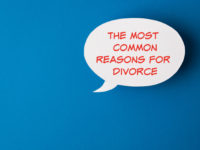What is the foundation of marriage? Society has been contemplating and debating this question for generations. Despite this age-old question, divorce rates are higher than ever both in the United States and globally. Current divorce rates hover around 40-50% for first marriages, 67% for second marriages, and an astounding 73% for third unions.[1] [2] Researchers have found that a typical marriage has about a 50% chance of survival.[3] Surprising? Maybe. Traditional marriage has steadily been on a downward trajectory with no uptick in sight. Recent surveys and statistics about marriage reveal that out of the 309 million Americans in 2014, there were 2.1 million marriages. This was a decline of over 100,000 marriages, as compared to the number of marriages in the year 2000. Statistics also demonstrate that 85% of people marry by the age of 46. Ironically, you know what else has a chance at happening by the age 46? Divorce — to the tune of a whopping 42% occurrence rate.[4]
Today, many millennials are rejecting the “sacred union" of traditional marriage or choosing to get married much later in life.[5] In fact, an unprecedented number omillennials remain unmarried through their forties. This doesn’t mean that millennials are afraid to commit; they are simply choosing to live together and postpone walking down the aisle.
Historically, marriage was an institution of economic and/or religious ends, not personal feelings (and it remains so today, in some cultures). In either case-- as a religious sacrament or as a means of economic strategy—neither of these premises imbued much if any value to the idea of personal happiness. Over time, however, as many unions have become more about personal choice, personal goals, and personal desires (as opposed to familial or spiritual responsibilities) that has opened the door to the other end of the spectrum as well . . . the personal decision that the marriage is no longer fulfilling the individual’s needs, wants, expectations, or goals.
Regardless of your reasons for choosing to divorce, you are not alone. Your decision was likely influenced by the prevailing problems and unresolved issues that cause many marriages to fail across the country. So, what can we blame for the high divorce rates? What are the most common reasons that cause couples to divorce?
While every couple is unique, there are undoubtedly some universal themes that cause marriages to fail. Here are some of the most common reasons:
Lack of Commitment
Why exactly does this characteristic prevent a lasting marriage? According to a survey conducted by the National Fatherhood Initiative, lack of commitment in a marriage was reported as the number one reason for divorce — above any other issue. A whopping 73% of survey-takers blame a lack of commitment — typically thought to be on the other spouse’s part — for the breakdown of their marriage.[6]
Keep in mind: a lack of commitment is more than a person’s unattached behavior; this trait encompasses a person’s willingness to work as a team with their partner and prioritize their marriage over other relationships and career aspirations.
Making your marriage a top priority means making the time to connect with one another. Typically, there are many excuses as to why couples don’t have time to go on dates or why they do not have opportunities to connect emotionally on a regular basis. But remember: these excuses reflect on how you and your spouse have and/or have not prioritized the relationship in context of all the other demands on you both. Finding the time, staying on track, and keeping yourself motivated can all be major challenges when you are trying to develop new habits. Learning to prioritize and claim time exclusively for your marriage is crucial for long-term success.
Lack of Autonomy
Autonomy is an important factor of any person’s life; it plays a critical role in feeling like a happy, well rounded individual. Many married couples become enmeshed to the point that one or both partners sense a loss of their independence and freedom. The ability to be with your spouse while also maintaining a sense of independence and individual identity are crucial pillars for a prosperous, long-term marriage.
A research study published in 1993 showed that 24% of men and 44% of women feel a lack of autonomy in their relationships.[7] These statistics may have changed since the date of the original study; however, it's interesting to note the differences between genders — and how this disparity may contribute to inequalities in gender roles.
Conflict
Conflict is the second most common issue leading to divorce. In fact, 56% of people surveyed said that conflict was an issue that prompted their divorce.[8] Couples who have called it quits due to arguing often made a conscious choice to stop arguing, either due to removing themselves from the situation or simply being unable to handle the conflict any further.
Conflict is not intrinsically a negative event. Conflict is simply the byproduct of differences coming into contrast. Conflict can be a dynamic opportunity for couples to learn more about each other, understand more about each other, discover more about themselves, and cultivate a deeper connection through nonjudgement and compassion. Conflict is—at its core—an opening for individual and partnership growth.
Conflict doesn’t refer to disagreement, or disdain for specific behaviors. Disagreement or irritation is an inevitable part of human relational functioning. Conflict in a marriage is continuous arguing and hostility without avail or resolution; or conclusions that are not reached calmly or effectively, or with mutual respect intact. It can be exhausting and disparaging to keep having the same arguments or to experience continuous tension in a union, so it makes sense that conflict is a common reason for divorce.
Other qualities of toxic conflict (as opposed to healthy differences) are defined by tone and quality. Combativeness—viewing conflicts or disagreements as battles in which there can only be one winner and one loser—is a quality of conflict that sends couples farther down the road of viewing the other person as The Enemy or The Bad Guy, and destroys the teammate dynamic that fosters constructive, partnership-based problem solving over assigning blame.
Infidelity
Another issue that can arise in a marriage is infidelity, which is commonly cited as a reason to divorce. Unfaithfulness — having an extramarital affair or emotionally cheating — is one of the most obvious reasons identified as a critical turning point in a deteriorating marriage. Understandably, infidelity was a significant divorce factor for 55% of divorcing individuals surveyed.[9]
There is no blanket explanation for why a cheating spouse chose to do so, emotionally or physically. Oftentimes, it was not the cheating spouse’s original intention to engage in a romantic affair when they initially became involved with another person. Many affairs begin as innocent friendships, and emotional affairs can eventually become physical over time. This leads us to wonder whether the underlying issue is more a lack of commitment, as mentioned above, or a general longing for attention from the other partner that eventually leads to an affair. When couples do not make time to nurture and maintain a connection with each other, individuals may begin to seek the fulfillment of those needs outside the marriage. While not every act of infidelity begins in such a manner, this is a common sequence of events.
Getting Married Too Young
Couples who get married at a young age can sometimes expect an uphill battle. Statistically, divorce is more common for a couple who was married at a younger age. About one-third of teen marriages end within 5 years, and nearly half of teen marriages end within 10 years.[10] According to the Single Parent Foundation, about 38.8% of men and 36.6% of women divorce after getting married when they were married between 20 and 24 years old.[11] Some exes report that they wish they had dated their partners for longer; that way they could have gained a better perspective on the relationship and make a more informed decision as to whom they should marry. Others feel that they were too young to make a mature, objective choice to marry.
Couples who marry young often report feeling like they missed out on a part of their youth. These people may be prone to temptations such as extramarital affairs and may engage in reckless behavior to sooth this feeling of loss.[12]
Inequality
Of those surveyed, 44% cited inequality as a major factor in deciding to dissolve their marriages.[13] Inequality comes in many forms. For example, it may be present when one partner feels burdened by a greater number of responsibilities in the home and within the family. It may emerge from feelings of resentment or discrimination. Feelings of inequality may arise if one spouse earns significantly more money than the other, causing one half of the couple to feel inferior to the other. Inequality can derive from themes of sexism and gender roles that no longer serve modern societal demands. Essentially, there are a variety of reasons that a person might not feel like an equal partner in a marriage, and the preceding examples are simply scraping the surface.
Unrealistic Expectations
A whopping 51% of survey participants stated that unrealistic expectations caused the end of their marriages. Couples often get married with the misimpression that the commitment will make all of their relationship issues magically disappear, or that it will cure their relationship overnight. This couldn’t be more inaccurate. Marriage takes an immense amount of work, an enduring willingness to compromise, and consistent effort to keep the sparks alive. Obviously, the early years may involve seemingly endless periods of romance and excitement, but the subsequent years may not be as hot and heavy (once the honeymoon phase has passed). Relationships change over the years as the individuals involved in them evolve, mature, and develop. Certain behavioral patterns and habits can drive wedges between spouses if they do not work to sustain healthy relational functioning and dynamics. There are many unrealistic expectations that couples take with them into their marriage, and these can cause preventable issues that — when not addressed —ultimately result in the deterioration of the relationship.
Financial Issues
It’s probably no surprise that money is often the most common cause of conflict in marriages and relationships. A study conducted by the American Psychological Association (APA) showed that nearly three-fourths of Americans experience stress surrounding finances, and that for 25% of Americans, that financial stress is extreme.[14] Another study found that 35% of couples attributed money as the main cause for their relationship stress and friction. Among those surveyed in the 44-54 age group, 44% said money was a primary cause for stressful relationship discourse.[15]
Abuse
Devastating physical, sexual, and/or emotional abuse was reported to be the cause of divorce in 29% of survey participants’ experiences. This is a shocking statistic and an issue that deserves more attention. The dissolution of an abusive marriage is far more complicated than a divorce without any instances of abuse. If you believe you are in an abusive marriage and wish to get out, ensuring your safety and the safety of any children is paramount before declaring your decision to divorce. It may also help to surround yourself with friends and family who can provide support and who are aware of the issue in the terrifying case that your situation becomes unsafe. Always remember that help is available.[16] While reaching out for support may feel scary, a therapist or advocate will do everything he or she can do to help you in a safe and nonjudgmental manner. It’s absolutely pertinent that you seek guidance during this process, because leaving is the most dangerous time in an abusive relationship.[17]
If you or someone you know is experiencing these problems and is contemplating a divorce, there are many professionals available to help. Do not hesitate to reach out for support and utilize every resource at your disposal, like the National Domestic Violence Hotline. This resource is available 24/7 at 1-800-799-SAFE. You are never alone in your struggle.
Individual Level Behaviors such as Substance Abuse or other Addiction
Addictive and substance use behaviors are significant factors in relational disruption. Alcohol use disorders in particular have been demonstrated to be highly predictive of divorce or separation, independent of other substance use or addictive disorders. Additionally, involvement with alcohol even short of meeting clinical criteria for a substance use disorder has significant predictive value for marital dissolution.[18] While substance addictions, gambling, and sex addiction may be the most obvious compulsive behaviors directly influencing relational satisfaction, the World Health Organization (WHO) recognizes a stunning number of behavioral dependencies, many of which have nothing to do with psychoactive substances.

Julia Rodgers is the business director of Mavrides Law. You can read her full bio here: Julia Rodgers' Bio
To speak with a lawyer about divorce or MA alimony matter, contact Mavrides Law in Boston or Wellesley, MA. To schedule an in-depth initial consultation, call 617-723-9900 or contact the firm at info@mavrideslaw.com
All content provided on this blog is for informational purposes only. You should not act upon any such information without first seeking qualified professional counsel on your specific matter. Mavrides Law makes no representations as to the accuracy or completeness of any information on this site. Mavrides Law will not be liable for any errors or omissions in this information nor for the availability of this information. These terms and conditions of use are subject to change at any time and without notice. Communication of information by, in, to or through this Website and your receipt or use of it (1) is not provided in the course of and does not create or constitute an attorney-client relationship, (2) is not intended as a solicitation, (3) is not intended to convey or constitute legal advice, and (4) is not a substitute for obtaining legal advice from a qualified attorney.
[1] “Marriage and Divorce”.
[2] Mark Banschick, “The High Failure Rate of Second and Third Marriages,” Psychology Today, last modified February 6, 2012, https://www.psychologytoday.com/blog/the-intelligent-divorce/201202/the-high-failure-rate-second-and-third-marriages.
[3] Ben Steverman, “Boomers Are Making Sure the Divorces Keep Coming,” Bloomberg, last modified June 17, 2016, https://www.bloomberg.com/news/articles/2016-06-17/boomers-are-making-sure-the-divorces-keep-coming.
[4] Allison Aughinbaugh, Omar Robles, and Hugette Sun, “Marriage and Divorce: Patterns by Gender, Race, and Educational Attainment,” Monthly Labor Review, U.S. Bureau of Labor Statistics, last modified October, 2013, https://www.bls.gov/opub/mlr/2013/article/marriage-and-divorce-patterns-by-gender-race-and-educational-attainment.htm.
[5] Meg Murphy, “NowUKnow: Why Millenials Refuse to Get Married,” Bentley University, accessed August 1, 2018, http://www.bentley.edu/impact/articles/nowuknow-why-millennials-refuse-get-married.
[6] Alan Hawkins, Brian Willoughby, and William Doherty, “Reasons for Divorce and Openness to Marital Reconciliation,” Journal of Divorce and Remarriage, 53, no. 6 (2012): 453-463.
[7] Leslie Baxter and Eric Simon, “Relationship Maintenance Strategies and Dialectical Contradictions in Personal Relationships,” Journal of Social and Personal Relationships, 10, no. 2 (1993): 225-242.
[8] Alan Hawkins, Brian Willoughby, and William Doherty, “Reasons for Divorce and Openness to Marital Reconciliation,” 453-463.
[9] Alan Hawkins, Brian Willoughby, and William Doherty, “Reasons for Divorce and Openness to Marital Reconciliation,” 453-463.
[10] Lauren Mann and Amy Kramer, “Divorce Rates for Teen Marriages Revealed,” MTV, last modified February 14, 2012, http://www.mtv.com/news/2382506/divorce-rates-teen-marriages/.
[11] “Statistics on Divorce,” The Single Parent Foundation, accessed August 1, 2018, http://thesingleparentfoundation.org/divorce/.
[12] Atkins, David C., Baucom, Donald H., & Jacobson, Neil S. (2001). Understanding Infidelity: Correlates in a National Random Sample. Journal of Family Psychology. 15(4), 735-749.
[13] Alan Hawkins, Brian Willoughby, and William Doherty, “Reasons for Divorce and Openness to Marital Reconciliation,” 453-463.
[14] Kelley Holland, “Three-quarters of Americans Are Stressed About This,” CNBC, last modified February 4, 2015, https://www.cnbc.com/2015/02/03/the-true-cost-of-financial-stress.html.
[15] Kelly Holland, “Fighting With Your Spouse? It’s Probably About This,” CNBC, last modified February 4, 2015, https://www.cnbc.com/2015/02/04/money-is-the-leading-cause-of-stress-in-relationships.html.
[16] The National Domestic Violence Hotline, accessed August 1, 2018, http://www.thehotline.org/.
[17] “Common Myths and Why They Are Wrong,” domesticviolence.org, accessed August 1, 2018, http://domesticviolence.org/common-myths/
[18] Cranford JA. (2014). DSM-IV alcohol dependence and marital dissolution: evidence from the National Epidemiologic Survey on Alcohol and Related Conditions. J Stud Alcohol Drugs. 75(3):520–529.





